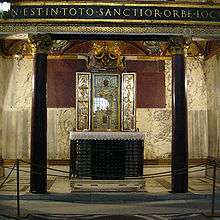Sancta Sanctorum

The Sancta Sanctorum (Italian: Chiesa di San Lorenzo in Palatio ad Sancta Sanctorum) is a Roman Catholic chapel entered via the Scala Sancta (Holy Staircase) of the Lateran Palace in Rome. It was the original private chapel of the papacy before it moved to Avignon, and later to the Vatican Palace. The chapel is the only building from the old Lateran Palace that was not destroyed during its reconstruction.
Name
The chapel acquired the Sancta Sanctorum sometime in the ninth century.[1] The spelling is Sancta, the neuter plural form of the Latin adjective "holy": this is a reference to the multiple relics preserved there (i.e. "the most holy things") and to the Holy of Holies in Jerusalem, traditionally called in Latin both sanctum sanctorum (the singular form) or sancta sanctorum.
History
The founder of the chapel is unknown. It was originally dedicated to Saint Lawrence, and served as the pope's private oratory until the Renaissance. It is located at the top of the Scala Sancta, ("Holy Stairs"). The first mention of the chapel is found in the Liber Pontificalis, during the tenure of Pope Stephen III (†772).
It formed part of the Lateran Palace, headquarters of the public offices of the papal court throughout the Middle Ages. Gregory IV (†844) had a private apartment built near the chapel to allow him to pray there.[1] It later became part of the Palace and Holy Steps complex commissioned by Sixtus V in 1586.[2]
Artwork

The chapel contains a cypress wood reliquary box, placed under the altar by Pope Leo III (†816). It supposedly houses the bones of at least 13 saints (whereof the chapel derives the name "holy of holies"). The reliquary box itself is taken to represent the Ark of the Covenant in Solomon's Temple.
Over the course of time, other relics were added, including the cloisonné enameled cross commissioned by Paschal I (†824).[2]
The ornate floor is by Cosmati done around 1278.[1]
The chapel also houses an icon of Christ Pantocrator, known as the Uronica, that was supposedly begun by Saint Luke and finished by an angel.
The artwork of the Sancta Sanctorum in Rome was the basis for the art at Assisi.[3]
References
- 1 2 3 "The Sancta Sanctorum", Scala Santa di Roma
- 1 2 "New Display of Sacred Objects from the Sancta Sanctorum", Patrons of the Arts in the Vatican Museums, September 1, 2015
- ↑ Brooke, Rosalind B., The image of St Francis: responses to sainthood in the thirteenth century, 2006, p. 352, "The vault of the Sancta Sanctorum is blue with gold stars, to represent the firmament, and so are the vaults of the transepts and apse at Assisi. The symbols of the Evangelists holding open books, each with an appropriate gospel text."